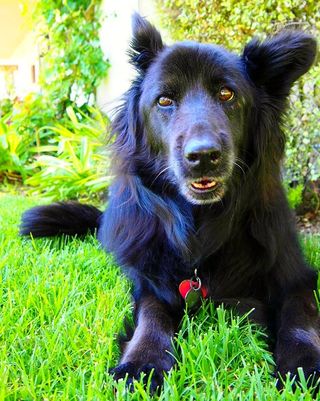People beg to hear the first part of this story. They never tire of it no matter how many times I’ve told it. Understandably, people find it heartwarming and uplifting to hear stories about losing something or  somebody they love only to have that someone, miraculously and against all odds, returned to them. It seems to happen more in the movies that in real life, but this time, it happened to us. But as many times as I’ve told this story, I usually shy away from the second, and probably the most important, second part. This is the story of how we lost our beloved dog, Gypsy, not once, but twice–and what I learned about the grief that ensued.
somebody they love only to have that someone, miraculously and against all odds, returned to them. It seems to happen more in the movies that in real life, but this time, it happened to us. But as many times as I’ve told this story, I usually shy away from the second, and probably the most important, second part. This is the story of how we lost our beloved dog, Gypsy, not once, but twice–and what I learned about the grief that ensued.
The first time, years ago, Gypsy escaped after our gardeners inadvertently let the gate open. Although in the past she’d jumped the fence and eventually found her way home after having a good ramble, this time dusk arrived without her return. We searched. We put signs on telephone poles, consulted psychics and hired professional dog trackers, but Gypsy, our sweet half-Belgium Shepherd and half mystery mutt, was gone and no one reported any sign of having seen her—except, bafflingly, a neighbor who claimed he saw me coaxing Gypsy into a truck I didn’t even own.
Days turned into weeks that turned into months. We thought about adopting a new dog, but my husband and I were in limbo, unable to grieve without knowing for sure what had happened—but unable to move forward, either. And so we did what most people do when they’re stuck: nothing.
Nine months after Gypsy’s disappearance, we got a phone call from a pound two hours away. Gypsy, who they’d found roaming a busy highway, was matted and filthy, but she was five pounds heavier than when she’d disappeared, which led us to hope she’d at least been well-fed. We were inexpressibly grateful to get her back.
Five years later, we lost Gypsy for real when what started as a slight limp turned into a fatal illness. We chose to let her live out her days until it was clear she had little to no quality of life left—a time that came sooner than we’d hoped. On the day we put her down, I came home, fell onto the couch and wept until I had no tears left.
It was an eerie echo of those excruciating months when Gypsy was missing, but this time, we knew what had happened, and it helped us lean into, rather than resist, our grief.
It helped us learn how to grieve, too. We found grief to be like nausea, coming and going without warning, and, like nausea, impossible to imagine feeling when it wasn’t present and impossible to imagine NOT feeling it when in the middle of it.
I realizedthat you cannot prepare for grief. You can intellectually imagine it, but nothing prepares you for the wave of emotions that overcome you when you experience the physical death of a loved one, a broken heart when someone breaks up with you or the end of a dream. It’s impossible to anticipate what or how you will feel. Period. There’s no manual for it. It’s not taught in school and rarely at home. It’s not something you can control or manage and there is no “right” or “wrong” way to grieve. Each person wears grief differently, in his or her own unique way.
The lessons I took away are these:
- Don’t armor up. We say we’re okay when we’re not. We force ourselves to smile when we don’t feel like it. We pretend to enjoy things we don’t. The real tragedy here is that this “I’m fine” coat of armor is deeply heavy and suffocating. It prevents us from what we really need during times of grief –connection to our feelings, to our soul and to the ones we could lean on.
- Sink into the pain. I really mean this. When I was grieving my pup, I impeded the process by thinking “I can’t handle this” or worrying that I’d never climb out of the well of sadness. Give yourself permission feel your feelings; make them as big as possible. What you allow to expand will often shrink.
- Unleash the floodgates. Make an appointment with grief. For 15 minutes everyday, crawl into a comfortable chair with your favorite blanket, a warm cup of tea or cocoa and flood your mind with memories of whatever you lost, your soul mate, your best friend moving away, your beloved pet.
- Wait. According to neuroscientist and Harvard professor Dr. Jill Bolte Taylor, if you allow yourself to truly feel the grief and pain, it will last for only 90 seconds, which is the most empowering thing I’ve heard about processing grief. She suggests that you watch it happen, feel it happen and then watch it go away. Grief and sadness is like the ebb and flow of an ocean wave. When you allow it to come in, it will naturally go out. When you resist it, it causes friction.
- You need a friend. Everyone needs a compassionate witness to listen to our grief. Find someone you are completely comfortable with, someone who loves you and share your memories, your feelings, and your thoughts with that person. We all need somebody to lean on.
Loss is a part of life, and therefore, so is mourning. It is in opening ourselves up to our most difficult feelings that we are able to process them and move forward. Give grief a chance, for it has much to teach you.
It’s been seven months since Gypsy passed and like the first time she was lost, we find ourselves talking about adopting another dog without being fully ready. For now, we still are processing the difficult feelings. We’re still leaning into the grief.




